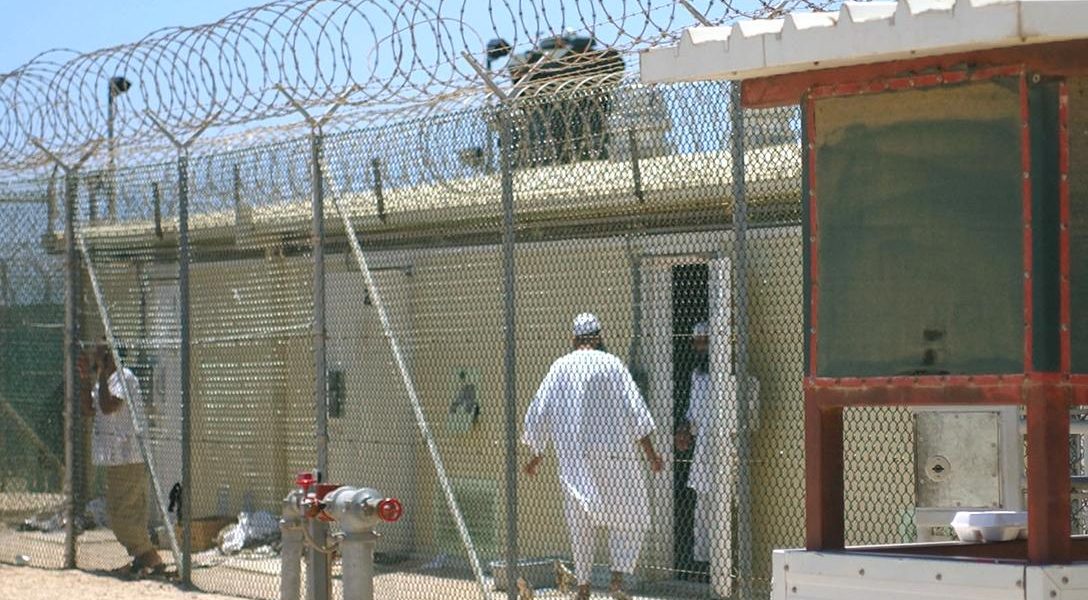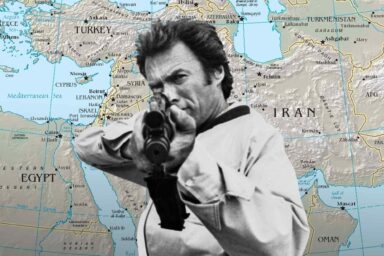A psychotherapist takes us face to face with the evil of torture and tells the story of a government that interfered with the gathering of evidence to stop it.
What is it like to bear witness to victims of torture? Psychotherapist Dr. Jeffrey Kaye, whose work for Survivors International took him inside the Guantanamo Bay detention facility, talks with WhoWhatWhy’s Jeff Schechtman about the experience of sitting with torture victims, how the numbing happens, and how the closer you get, the more you want to look away.
Torture that was never intended to get information, Kaye says, but instead to create dependency, weakness and dread. Antimalarial drugs have been used on detainees, though not for malaria, but because they have such awful and disorienting side effects.
Equally powerful is Kaye’s description of how all of this was logged and managed with a Detainee Management System that was state-of-the-art, a high-tech tool for the most primitive kind of behavior.


Click HERE to Download Mp3
Full Text Transcript:
Jeff Schechtman: Welcome to Radio WhoWhatWhy. I’m Jeff Schechtman.
Eight years ago, the American people were promised that Guantanamo would be closed. That has not yet happened. The reasons given by the Obama Administration have been many, yet in all of this debate, the focus is always abstract. Guantanamo is a place as a piece of government real estate, almost nowhere is the debate about what’s going on there now, what’s happened there and what’s been done there in the name of security and of the American people. If you listen to the political debate today, you’ll hear none of this but you will hear it today from my guest, Jeffrey Kaye.
Jeffrey Kayee is a graduate of the University of California Berkeley, he’s a clinical psychologist here in the San Francisco Bay Area, he’s taught adult development and history and systems of psychology to graduate students and for ten years he worked part time with Survivors International, conducting both assessments and psychotherapy. It is my pleasure to welcome Jeffrey Kayee here to talk about his book Cover-up at Guantanamo: The NCIS Investigation into the “Suicides” of Mohammed Al Hanashi and Abdul Rahman Al Amri. Jeffrey Kayee, thanks so much for joining us here on Radio Whowhatwhy.
Jeffrey Kayee: Thanks very much Jeff, I’m really happy to be here.
Jeff Schechtman: It’s a delight to have you here. First of all, talk a little bit about your own personal interest and your own personal understanding of Guantanamo and what’s been going on there. How did you come to this?
Jeffrey Kaye: You mentioned that I worked for Survivors International and I do talk a little bit about this in the book and it is a life changing event to sit down with a torture survivor and interview them about what they went through, which was in essence, my job one way or another to do. And it’s life changing because it’s amazing – the degree in which the inhumanity of various governmental systems, that includes the United States, can take and objectify human beings and try to break them and what makes the United States’ efforts to do this so unique is they try to do this by so called scientific means. So they include doctors and psychologists, and they study these things and they do experiments upon these things and I’m a psychologist and I came to it later in life. To be a psychologist and a healer was an important part of my identity, and here I was face to face as the scandal leaked out around the lead up to the Iraq War and just afterwards Abu Graib that the United States itself was involved, heavily involved in torture and that psychologists were involved in creating the programs for that torture and also in doing the torture or advising the torturers. That presented an ethical dilemma to me and to others in my field, by the way, that one could just sit by and do nothing or one could bear witness and try and either stop these terrible things from happening or to at least to notify the public and make a mark in history so that people would know that these terrible events were taking place. And that’s what I’ve done and that’s really what this book is about.
Jeff Schechtman: I want to talk also about the other side of the ethics in all of this, and that is the ethics and the reconciliation of those in the medical community, those that take an oath to do no harm, be they in the mental health field or be they regular doctors that are part and parcel of what’s been going on with respect to torture and in places like Guantanamo.
Jeffrey Kaye: Well, there are a number of different responses. The primary response is to numb oneself to it, to feel helpless in the face of it or to turn away from it. In the book, in fact I tried to explain how psychologically this happens because it’s really quite horrific and people really do not want to look upon such horrible things and particularly the closer it is, the more you might want to look away. Now the people of course who involved themselves, I haven’t talked to many of them, they don’t really want to talk to me but to the degree I’ve read about them, had some encounters with them briefly and have read the disputes that go on behind the scenes between the fight over psychological ethics, for instance in the American Psychological Association exactly on these issues. What you find is that these people set up another way of dealing with it, rationalization is put forward, that these things are important, that they’re doing good for the country, they’re fighting terrorism. They put forth the ticking bomb scenario, we must sometimes do these things. And then there’s the John Yoo defense, which is a kind of (5:18.5-5:20.1pedagogging?), legalistic defense which says well, we’re really not torturing here you see, because the US government’s attorney says this isn’t torture, so it’s not torture. So there’s a number of different responses to that.
Jeff Schechtman: One of the things you talk about is really the nature of the torture itself. We’re used to hearing a lot about waterboarding, but you talk about it in a much more medicalized and much more scientific way in terms of what’s been done, what’s been undertaken and the usage of various drugs in this process. Tell us about that.
Jeffrey Kaye: Yes, well you know the US Government, the Department of Defense and the CIA studied ways to break down individuals, what we of course called torture for literally decades. That was part of their MK Ultra program, they wrote a manual of interrogation and torture which you can find online called the KUBART Manuals. In fact today the most recent and most opened version from the CIA that we’ve gotten via the Freedom of Information Act was one that I obtained recently which brought out even more information about what’s in that manual. But yeah, the waterboarding, as horrific as it is, perhaps only took place in a handful of individuals. In other words, the government said only three, it was certainly at least twice that and then there were various forms of water torture that come very close to what waterboarding was that took place on dozens of detainees, a number including at Guantanamo. But the kinds of torture that the government came up with follows a formula they themselves called DDD, like Dog Dog Dog, but the Ds stand for: Dependency, Debility, which means weakness and Dread, and that’s their formula. They use it even today in Guantanamo. The United Nations recently called out the United States for some of the techniques they still use in their army field manual and these techniques are based on things such as sleep deprivation, the isolation of individuals from other people, sensory deprivation, the isolation of people from stimuli and perceptual organization, sometimes sensory overload and sometimes the use of drugs. In fact, in the book Cover Up in Guantanamo I talk about the bizarre but true strange use of anti-malarial drugs, not to prevent malaria but for the terrible side effects they cause: disorientation, dizziness and even sometimes psychosis and hallucinations on some people to disorient them. It too, drugs were used to break down individuals. In the death of Abdul Rahman Al Amri, his autopsy report specifically says in its toxicology section that they tested specifically for the drug mefloquine, which is a very controversial drug, many of your listeners maybe know it as lariam, which the United States Department of Defense has essentially ordered to stop being given to US soldiers because of the terrible side effects and even deaths that have occurred from this drug. It tends to drive people to suicide, for instance, some people, not everyone. There’s this clear evidence that these drugs were used and the bottom line of it all is that they weren’t used really to get information but in their own language, to manipulate and to exploit prisoners, detainees for their own purposes. Now sometimes that might be information, sometimes it would be to turn them and make them stool pigeons, squealers against their compatriots, sometimes for false confessions, sometimes for show trials. This is how it has been used by other governments and it’s also how torture of this type is used by the United States government.
Jeff Schechtman: What if anything was going on, in terms of monitoring all of this. Was there any central record keeping, central effort on the part of the government to keep track of all of this?
Jeffrey Kaye: Well, there’s a lot of controversy over that and how you would even make sense of that information. Now certainly, the intelligence agencies involved, for instance the Defense Intelligence Agency or the Central Intelligence Agency, they kept records of so-called intelligence of the interrogations that were taken. And I don’t know, none of us know and we can only surmise what types of records were kept of the kind of experimental approaches that they were taking and the responses of detainees to these approaches. But one really public example did come out: it was published by Time Magazine. It was the interrogation logs of the detainee number 063, also known as Al-Qahtani and they were published in Time Magazine. You can read them online, people can Google them and what it was, was a record of his responses to the various types of interventions. Like, let’s see how he responds when we wake him up after ten minutes’ sleep, let’s see how he responds if there are barking dogs on him, let’s see how he responds if we pour water over his bed, which they did. They weren’t keeping records of what he said, in other words, this is not an interrogation log. This is a log of his behavioral responses to torture interventions and I suspect there must be many, many, many more logs like this. There were also video tapes taken, many, many hours of videotapes and of course quite famously is the destruction of such videotapes by the CIA that apparently spurred the Senate Intelligence Committee in a recent investigation into the CIA torture program that was in the news in the past few years. So these are some of ways they kept track of what they were doing.
Jeff Schechtman: What was the detainee information management system?
Jeffrey Kaye: The detainee information management system was a computerized system that was mandatory for use at Guantanamo and still is. It was implemented after the first few years of Guantanamo. After the initial controversy over prisoner abuse came out, the Pentagon instituted this system which is kind of similar to, in some ways putting videotapes on cops because they’re shooting people. They thought: we’re going to log everything that happened, every moment. If a detainee wants to lead a prayer, we’re going to log it. If a detainee cries, we’re going to log it. If we have to make a detainee – this is literally in their manual – kneel down so we could put the shackles on them, we’re going to put down how they kneeled and if there was any deviation, and there was every single fact about detainee life. And how they were treated by the guards and medical personnel were to be recorded in this detainee information management system. Headcounts every hour, who was in the prison cells, etc. And the reason you bring this up and I make a huge thing of it in the book, is that in almost every case which I’ve looked at in any depth of the detainee deaths that took place in Guantanamo, in each case, these computer logs were manipulated and in one case, they were literally shut down which goes totally against standard operating procedure so that they could alter or affect, in essence the historical record, the factual record of what was happening. It was meant to be a safety device so that we’d know and we could prove that abuse wasn’t taking place but what we see is every time there’s the potential of serious misconduct such as death or possibly murder taking place, that system was manipulated or shut down. After I applied my Freedom of Information Act request on the death of one of the detainees, the main one that I talk about in the book: Mohammed al-Hanashi, the logs from that system literally disappeared for 2 days; the crucial two days, the day the detainee died and the following day, disappeared from the record entirely, they were “missing”. So it’s an incredibly important computer system, what Guantanamo authorities themselves rely on to understand exactly what’s happening and my point in the book is to show one of the primary evidences of the manipulation of that system. In the case of al-Hanashi, the charge was that it was shut down itself by NCIS, Naval Criminal Investigative Service, the very agency that was supposed to be investigating the deaths, ordered immediately after al-Hanashis death that the system be shut down and nothing further recorded in it, which is quite amazing. Then they did their own investigation of themselves as to what happened, an investigation which ultimately went nowhere.
Jeff Schechtman: To what extent do we know that any of these activities were taking place in other places and in other sites outside of Guantanamo?
Jeffrey Kaye: Well, we know that from the statements of other prisoners who had been held in places like Bagram or certainly in the CIA black sites, but we know it from the leaked report of the International Committee on the Red Cross on prisoners that they saw in the CIA black sites but also their leaked report over ten years ago on abuse that was taking place of course, in Guantanamo. We have evidence from other journalists: Jeremey Scahill, who reported on prisoner abuse taking place in CIA run, although staffed by local people, prisons in Somalia and their war on terror that the US is leading there. So how much we know about all of these things of course is… I have not myself made an encyclopedic study of all the different sites but there have been many reports, reports by Amnesty International, reports by the Open Society Foundations, we basically know from the work of different NGOs, journalists and the statements of former prisoners themselves.
Jeff Schechtman: Talk a little bit about these two suicides and what happened.
Jeffrey Kaye: Well, the earlier suicide that I’m discussing in the book was that of a man by the name of Abdul Rahman al Amri. He was a Saudi Arabian, a bit older than many of the other detainees in that he was in his 30s. He had been in the Saudi Arabian military. He had been trained in fact, by the Americans in the use of anti-tank weaponry and I assume other military matters. He had apparently – by his own account – been addicted to drugs,
a heavy drug user who then had a kind of religious awakening in terms of Islam and he went to Afghanistan to fight for jihad, which meant at that time to fight for the Taliban in the Civil Wars that were happening within Afghanistan at the time and got swept up when people were being arrested after 9/11, after the CIA and Special Forces went in, and was sent to Guantanamo. There apparently, he was cooperative according to some accounts with the Americans. In fact, one of the Americans according to an Associated Press account, that people were planning suicides and were getting desperate inside Guantanamo and that they should watch out. He also though, was a hunger striker as well. We have records of his weight changes and they gyrated fantastically, almost unbelievably. He could gain or lose 25-50 pounds in a month and this went up and down like a yoyo and this was the same for the other detainee I studied as well. On May 30, 2007, he was reportedly found dead in his cell. The story goes that he hanged himself by tearing strips from his bedsheet and fashioning a rope from it that he then tied to the air grating in his room and put around his neck and hanged himself until he was dead. He also somehow did all of this while being under near constant surveillance at a minimum, so far as I could tell being looked in upon every 3 minutes in his cell. By the way, he also somehow found time to tear off a strip of his bedding and tie his hands behind his back, if you believe the government authorities. All of that sounds very suspicious to me and quite remarkable. What made it even further suspicious, when I got the documents from the Freedom of Information Act is I discovered there was yet another sheet that he supposedly fashioned that was subsequently thrown out possibly in the medical trash, which means once he was brought to the hospital outside of his cell, and we don’t know exactly what that other piece of torn sheet was used for, but I speculate that it was used as a gag or used for a procedure known as dry-boarding, which Professor Almerindo Ojeda at University of Davis has documented occurred with other detainees, which is essentially a form of suffocating people to make them talk although if you do it too much, you might actually kill them. Whether that’s exactly what happened to al-Amri, I don’t know but that is reportedly, what happened to three detainees who died, who were found almost exactly like al-Amri: in their cells, hanged, with their hands bound although in front of them, not behind and they also had some kind of mask on their face, which al-Amri so far as I know, did not. But like al-Amri, they too were tested for the presence of certain anti-malarial drugs: chloroquine and in one case, mefloquine, just as al-Amri was tested for. The circumstances are so similar that I have to wonder, and I don’t know what was happening, what it was all about. Joe Hickman, who did a book on this, he was a former guard at Guantanamo said it was due to experiments that were happening and that he himself had witnessed what was most likely these three detainees in 2006 sent to a CIA black site on Guantanamo and then brought back later that night. So he was one of the detainees that I write about and there are a lot of questions about his death. The bedsheet that supposedly he used to fashion a rope, according to other accounts, that would have been impossible because after the deaths in 2006, bedsheets were changed to a type that could not be torn or ripped or cut and also were taken away every night, every day rather from the detainees and only given back at night – in time for them to go to sleep. He was discovered during the day, a time when there should’ve been no sheet there. In other words, there are so many questions, so many implausibilities that the story of his death really makes no sense and it raises a host of questions all of which had been almost, except for maybe the first month after he died in 2007, have essentially disappeared off the public radar entirely.
Jeff Schechtman: And the death of Hanashi?
Jeffrey Kaye: Hanashi was a younger man. He was only about 23 years old or so when he was captured in Afghanistan and also sent pretty much directly to Guantanamo. He was fighting with other foreign fighters for the Taliban and had been taken prisoner by the Northern Alliance, which were the people that were fighting in the civil wars in Afghanistan and according to certain accounts, was even some kind of leader in trying to negotiate for the freedom of these prisoners at the time. He was also supposedly present, how involved we don’t know, he says he never shot anybody in a prison uprising that took place in Afghanistan. The WikiLeaks document – WikiLeaks released a number of documents, people might know about the detainees – apparently came from Guantanamo and they wanted to exploit al-Hanashi’s understanding of what happened at that prison uprising and whether he was a leader of some sort in their interrogations. But Hanashi very quickly became quite mentally ill and went in and out of the mental ward at Guantanamo: the behavioral health unit, the BHU which is the acronym used for short. And he made numerous suicide attempts within the few years he was there. He entered in 2002, he died on June 1, 2009 and in the weeks leading up to his death, he had made approximately 4 or 5, I mean what account you want to believe, suicide attempts, including one horrific one in which he ran and tried to crack his head open by running straight into a metal bolt that was on a fence in the recreation yard and when that didn’t work, he tried to strangle himself to death with a t-shirt. He made other attempts as well and he was in the behavioral health unit and at the day that he died, he was interviewed by both the commander of the camp and the chief psychologist. The commander of the camp apparently came to see al-Hanashi to explain that they were changing the rules inside the behavioral health unit in the hospital itself. The hospital would have no special privileges anymore, that from now on, they would be run according to the other rules of the camp and the rules of the camp in Guantanamo are quite harsh indeed. From every piece of toilet paper to food you ate, everything was controlled, monitored, used as a reward or punishment and that included of course, rules that had you sent from cell to cell to cell so that you could never settle down and even make your tiny little cell any kind of home. Al-Hanashi went, he left a suicide note, and I reprint the note in the book. By the way, all the documents I got can be viewed online at guantanamotruth.com for you listeners out there, including the suicide note of al-Hanashi, where he describes the final thing that happened that led him to decide – he put it “no solution but death”. And that was that he went to the chief psychologist to ask him for help, that he felt that he was being tortured in the camp and that he needed help and that these new rules were too much to bear. When he said he was being tortured, well we also have the testimony not just of al-Hanashi but of the chief psychologist himself – he said when he or any other detainee, because apparently there were others who came to him and said “there’s torture going on,” I’d just turn on my heel and walk away. He would not even engage them on the issue. But when this happened to al-Hanashi that day, he was shocked; shocked in a way in which the hopelessness and suicidality he had was apparently redoubled and he said “I now know there’s no solution but death for me,” and in fact later that day, he died. But the means of that death also call out a lot of questions. I in the book, my hypothesis is that unlike the death of al-Amri and the 2006 detainees, I think that it’s very possible al-Hanashi was not per se the subject of an experiment outside of how you consider the torture. And the whole camp itself was a huge experiment, but in the sense that he was given the materials, their backs were turned at the right time, machines shut down, allowed him to kill himself. He was already quite suicidal and he was found in his cell, supposedly the mode of suicide was that he had ripped part of his underwear, the elastic band around your briefs, many men I’m sure wear cotton briefs out there who are listening, they know what I’m talking about. He wrapped it around his neck and supposedly twisted it and twisted it until it was so tight he strangled himself to death. Not an easy thing to do by the way, but that’s what they said he did. But of course, what makes this, number one, suspicious from the get-go is once again, he’s being monitored near constantly in the cell and, number two, the type of underwear that he supposedly was able to fashion, ligature they call it, the thing he put around his neck to kill himself, was not the type of underwear that prisoners were distributed in Guantanamo. In fact, again after the 2006 suicides, they were supposedly so freaked out that there would be more suicides, they made sure the only kind of underwear that the detainees had, brief type underwear weren’t cotton briefs, but a very flimsy, boxer type of underwear that apparently couldn’t sustain any weight or any ripping or anything like that, really shoddy underwear that would fall apart if stretched. There’s much, much more – I could go on with your listeners, but that’s who al-Hanashi was and how he died.
Jeff Schechtman: Real quickly, why was Hanashi there? How did he wind up in Guantanamo?
Jeffrey Kaye: He was a prisoner and had been fighting with the Taliban. He had been captured at a battle that took place in Afghanistan and he was one of a number of prisoners who had been captured at this battle and brought to a prison there. Again, there was a prison riot and after this riot was put down – prison riots by the way, where the very first American died: Mike Spann, a CIA contract agent and he was captured there, sent to a hospital because he had been wounded in that prisoner uprising and then sent from there to Guantanamo.
Jeff Schechtman: To what extent is any of this activity the kind of things you’ve been talking about, to what extent is it going on today?
Jeffrey Kaye: Well, of course there are still prisoners at Guantanamo and there are prisoners in other war-on-terror sites that the United States government runs. We don’t know them all, secrecy is still quite tight. Many of these prisons now are just run by US clients, prisoners are held there. An example at the time of Al-Hanashi’s death was Ibn al-Shaykh al-Libi, who supposedly had given the information about Iraq’s use of weapons of mass destruction to the Americans that led to Powell’s use at the UN to justify the invasion of Iraq, but he was imprisoned at Guantanamo. But later, we don’t know when, he was sent to Libya and that’s where he was held until he supposedly committed suicide, a month or so or a little less before the death of al-Hanashi, but he was in a Libyan prison. We know that Obama has been slowly, very slowly emptying or semi-transferring prisoners out of Guantanamo. But there are still, I don’t know the exact figure today, 16 something prisoners I believe still in Guantanamo, a dozen or so of whom are of high value detainees held in a special camp just for them – Camp 7, supposedly to go on trial for military commissions. I think we can assume there are still prisons, Obama never shut down their rendition program that the CIA had, or George Bush rather had, although he claimed that they don’t rendition to torture anymore. So we know there are indications, there have been stories written but the full extent of it has still been kept secret. The government is extremely secret about what they do.
Jeff Schechtman: Jeffrey Kaye, the book is Cover Up at Guantanamo. Jeffrey, I thank you so much for spending time with us on WhoWhatWhy today.
Jeffrey Kaye: Thank you very much. I was glad to be here.
Jeff Schechtman: Thank you for listening and joining us here on Radio WhoWhatWhy. I hope you join us next week for another Radio WhoWhatWhy podcast. I’m Jeff Schechtman.
If you liked this podcast, please feel free to share and help others find it by rating and reviewing it on iTunes. You can also support this podcast and all the work we do by going to WhoWhatWhy.org/donate.
Related front page panorama photo credit: Adopted by WhoWhatWhy from Jeffrey Kaye (Twitter) and Guantanamo Bay prisoners (US Department of Defense)



